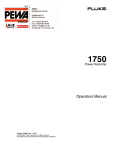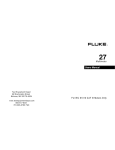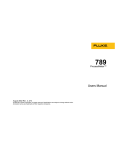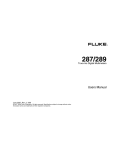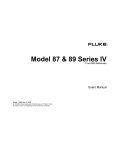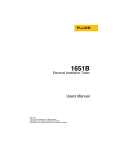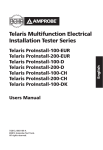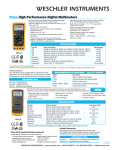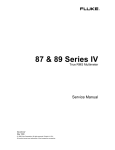Download Fluke 183-185
Transcript
® 183/185 True RMS Multimeter Calibration Manual PN 1610436 May 2001 Rev.1, 6/02 © 2001-2002 Fluke Corporation, All rights reserved. Printed in USA All product names are trademarks of their respective companies. LIFETIME LIMITED WARRANTY Each Fluke 20, 70, 80, 170 and 180 Series DMM will be free from defects in material and workmanship for its lifetime. As used herein, “lifetime” is defined as seven years after Fluke discontinues manufacturing the product, but the warranty period shall be at least ten years from the date of purchase. This warranty does not cover fuses, disposable batteries, damage from neglect, misuse, contamination, alteration, accident or abnormal conditions of operation or handling, including failures caused by use outside of the product’s specifications, or normal wear and tear of mechanical components. This warranty covers the original purchaser only and is not transferable. For ten years from the date of purchase, this warranty also covers the LCD. Thereafter, for the lifetime of the DMM, Fluke will replace the LCD for a fee based on then current component acquisition costs. To establish original ownership and prove date of purchase, please complete and return the registration card accompanying the product, or register your product on http://www.fluke.com. Fluke will, at its option, repair at no charge, replace or refund the purchase price of a defective product purchased through a Fluke authorized sales outlet and at the applicable international price. Fluke reserves the right to charge for importation costs of repair/replacement parts if the product purchased in one country is sent for repair elsewhere. If the product is defective, contact your nearest Fluke authorized service center to obtain return authorization information, then send the product to that service center, with a description of the difficulty, postage and insurance prepaid (FOB Destination). Fluke assumes no risk for damage in transit. Fluke will pay return transportation for product repaired or replaced in-warranty. Before making any non-warranty repair, Fluke will estimate cost and obtain authorization, then invoice you for repair and return transportation. THIS WARRANTY IS YOUR ONLY REMEDY. NO OTHER WARRANTIES, SUCH AS FITNESS FOR A PARTICULAR PURPOSE, ARE EXPRESSED OR IMPLIED. FLUKE SHALL NOT BE LIABLE FOR ANY SPECIAL, INDIRECT, INCIDENTAL OR CONSEQUENTIAL DAMAGES OR LOSSES, INCLUDING LOSS OF DATA, ARISING FROM ANY CAUSE OR THEORY. AUTHORIZED RESELLERS ARE NOT AUTHORIZED TO EXTEND ANY DIFFERENT WARRANTY ON FLUKE’S BEHALF. Since some states do not allow the exclusion or limitation of an implied warranty or of incidental or consequential damages, this limitation of liability may not apply to you. If any provision of this warranty is held invalid or unenforceable by a court or other decision-maker of competent jurisdiction, such holding will not affect the validity or enforceability of any other provision. Fluke Corporation P.O. Box 9090 Everett, WA 98206-9090 U.S.A. 2/02 Fluke Europe B.V. P.O. Box 1186 5602 BD Eindhoven The Netherlands Table of Contents Title Introduction ....................................................................................................... Contacting Fluke ............................................................................................... Precautions and Safety Information .................................................................. Safety Precautions......................................................................................... International Symbols ................................................................................... Specifications .................................................................................................... Basic Maintenance............................................................................................. Opening the Meter Case................................................................................ Removing and Reinserting the Circuit Board Assembly .............................. Replacing the LCD........................................................................................ Reassembling the Meter Case ....................................................................... Testing the Fuse ............................................................................................ Replacing the Fuse ........................................................................................ Battery Replacement ......................................................................................... Cleaning............................................................................................................. Performance Tests ............................................................................................. Required Equipment...................................................................................... Testing the Display ....................................................................................... Backlight Test ............................................................................................... Keypad Test .................................................................................................. Testing Meter Accuracy................................................................................ Frequency Test .............................................................................................. Duty Factor Test............................................................................................ Current Test................................................................................................... Continuity Test.............................................................................................. IR Port Verification Test ............................................................................... Calibration Adjustment ..................................................................................... Replacement Parts and Accessories .................................................................. i Page 1 1 2 2 3 3 12 12 14 14 16 17 17 17 18 19 19 20 20 20 20 23 23 25 26 26 27 28 183/185 Calibration Manual ii List of Tables Table 1. 2. 3. 4. 5. 6. 7. 8. 9. 10. 11. 12. 13. 14. 15. 16. 17. 18. 19. 20. 21. 22. 23. 24. 25. Title International Symbols ............................................................................................ DC Voltage Characteristics.................................................................................... DC Voltage Range, Resolution, and Accuracy...................................................... AC Voltage Characteristics.................................................................................... AC Voltage Range, Resolution, and Accuracy...................................................... DC Current Characteristics .................................................................................... DC Current Range, Resolution, and Accuracy ...................................................... AC Current Characteristics .................................................................................... AC Current Range, Resolution, and Accuracy ...................................................... Resistance (Ω) Characteristics............................................................................... Resistance Range, Resolution, and Accuracy........................................................ Continuity Characteristics...................................................................................... Diode Test Characteristics ..................................................................................... Capacitance Range, Resolution, and Accuracy (5,000 counts only) ..................... Frequency Characteristics, Resolution, and Accuracy........................................... Frequency Voltage Range...................................................................................... Duty Factor Characteristics.................................................................................... Temperature Characteristics .................................................................................. FAST MIN MAX (1 ms) Characteristics............................................................... Physical Characteristics ......................................................................................... Environmental Characteristics ............................................................................... Certifications and Compliances ............................................................................. Required Performance Test Equipment ................................................................. Verification Table .................................................................................................. Required Equipment for Calibration Adjustment .................................................. iii Page 3 4 4 4 5 5 6 6 6 7 7 7 8 8 9 9 9 9 10 10 10 11 19 21 27 183/185 Calibration Manual iv List of Figures Figure 1. 2. 3. 4. 5. 6. Title Opening the Case ................................................................................................... Connector Pin ........................................................................................................ Removing LCD Mask to Access LCD................................................................... Reassembling the LCD .......................................................................................... Replacing the Batteries .......................................................................................... Display Test ........................................................................................................... v Page 13 13 15 16 18 20 183/185 Calibration Manual vi 183 & 185 Maintenance and Calibration Introduction W Warning To avoid shock or injury, do not perform the verification tests or calibration adjustment procedures described in this manual unless you are qualified to do so. The information provided in this document is for the use of qualified personnel only. WCaution The 183/185 Multimeters contain parts that can be damaged by static discharge. Follow the standard practices for handling static sensitive devices. The information in this manual deals with the Fluke Models 183 & 185 True RMS Multimeters, (hereafter referred to as “the meter”). Information provided includes: • • • • • • Precautions and safety information Specifications Basic maintenance (cleaning, replacing the battery and fuse) Performance test procedures Calibration adjustment Accessories and replaceable parts For complete operating instructions, refer to the Model 183 & 185 Users Manual. Contacting Fluke To order accessories, receive assistance, or locate the nearest Fluke distributor or Service Center, call: USA: 1-888-99-FLUKE (1-888-993-5853) Canada: 1-800-36-FLUKE (1-800-363-5853) Europe: +31 402-678-200 1 183/185 Calibration Manual Japan: +81-3-3434-0181 Singapore: +65-738-5655 Anywhere in the world: +1-425-446-5500 Address correspondence to: Fluke Corporation P.O. Box 9090 Everett, WA 98206-9090 USA Fluke Europe B.V. P.O. Box 1186 5602 BD Eindhoven The Netherlands Visit us on the World Wide Web at: www.fluke.com Precautions and Safety Information WWarning If the Meter is used in a manner not specified by the manufacturer, the protection provided by the equipment may be impaired. Read the “Safety Information” page before servicing this product. In this manual, a Warning identifies conditions and actions that pose hazard(s) to the user; a Caution identifies conditions and actions that may damage the Meter or the test instruments. Safety Precautions WWarning • • • • • • • • • • • 2 Only qualified personnel should perform service procedures. To avoid fire or personal injury: Connect and disconnect properly. Do not connect or disconnect probes or test leads while they are connected to a voltage source. Observe all ratings and markings on the meter. Consult the meter user manual for further ratings information before making connections to the meter. Do not apply a potential to any terminal, including the common terminal, that exceeds the maximum rating of that terminal. If the meter is used in a manner not specified by the manufacturer, the protection provided by the equipment may be impaired. Replace batteries only with the proper type and rating specified. Do not operate the meter with covers or panels removed. Use only the fuse type and rating specified for this meter. Avoid exposed circuitry. Do not touch exposed connections and components when power is present. If you suspect there is damage to the meter, have it inspected by qualified service personnel. Do not operate in wet/damp conditions. Do not operate in an explosive atmosphere. Keep meter surfaces clean and dry. This meter is sensitive to strong external magnetic fields. Do not use the meter within 1-inch (2.54 cm) of strong external magnetic fields such as that produced by the Fluke ToolPak hanging magnet accessory. Incorrect readings may result. If erratic behavior is noted, turn meter off to reset. Maintenance and Calibration Specifications International Symbols International symbols used on the Meter and in this manual are explained in Table 1. Table 1. International Symbols Y W T M Risk of electric shock Risk of danger. Important Information. See manual Equipment protected by double or reinforced Insulation Battery Conforms to CSA C22.2 No 1010. 2.032-96 P J D ; Conforms to EU directives Earth AC or DC Conforms to relevant Australian standards N10140 Inspected and licensed by TÜV Product Services VDE Conforms to VDE EN61010 Specifications All specifications are warranted, unless noted as typical, for the rated temperature range of 23 °C ± 5 °C at less than 80% relative humidity. Characteristics Description LCD display digits 3 4/5 (default) or 4 4/5 Display counts 5,000 (default) or 50,000 Bargraph 20 segment, updated 20 times per second Memory locations 183: 10, 185: 30 Out of range indicator OL: overrange Ur: underrange Low voltage indicator Battery symbol shows on LCD at 2.0 V. Meter powers down at 1.5 V. Battery life 100 hours continuous use with backlight off (typical) Auto-off Adjustable, 30 minute default Power source Two AA 1.5 V alkaline batteries (NEDA 15 A) Maximum input voltage between terminals and between terminals and earth. 1000 V RMS Installation Category III (CAT III) F1 fuse protection 11 A (1000 V) service-replaceable Backlight Green LEDs 1. 1 If the meter is exposed to water have it inspected by qualified service personnel. 3 183/185 Calibration Manual Table 2. DC Voltage Characteristics Characteristic Description Settling time 3 readings (typical) Reading rate 5,000 ct.: 4 readings per second 50,000 ct.: 1 reading per second Rejection ratio Common mode 120 dB at DC or 50 Hz or 60 Hz Normal mode 60 dB at 50 Hz or 60 Hz Input impedance 10 MΩ (typical) Table 3. DC Voltage Range, Resolution, and Accuracy 1 Resolution Range 5,000 counts 50,000 counts 0.5 V 100 µV 10 µV 5V 1 mV 100 µV 50 V 10 mV 1 mV 500 V 100 mV 10 mV 1000 V 1V 100 mV Temperature coefficient 1. Accuracy 183 185 ± (0.07% + 1 count) ± (0.05% + 1 count) Add (0.005% + 0.1 ct.)/°C to accuracy beyond rated temperature range. Accuracy in 50,000-count mode is % + 10 counts. Table 4. AC Voltage Characteristics Characteristic Description Input impedance 10 MΩ in parallel with 100 pF (typical) Settling time 4 readings (typical) Reading rate 5,000 ct.: 4 readings per second 50,000 ct.: 1 reading per second Common mode rejection ratio 60 dB at DC to 60 Hz Crest factor, maximum Full scale: 3 Half scale: 6 1 AC+DC total RMS volts accuracy 1 AC DC dual display accuracy AC (RMS) accuracy + 0.1% + 1 count DC Accuracy + 0.05% + 1 count AC RMS Accuracy + 0.1% + 1 count Upper display frequency (5,000 counts) Accuracy ± (0.002% + 1 count) for 20 Hz to 20 kHz Sensitivity 10% of selected voltage range dB reference 2 1 VRMS (adjustable) 2 dBm reference 775 mV across 600 Ω (1 mW) 1. 5,000-count mode only. 2. See "dB and dBm Voltage Measurements" in the users manual for dB and dBm calculations. 4 Maintenance and Calibration Specifications Table 5. AC Voltage Range, Resolution, and Accuracy Resolution Range 5,000 Counts Accuracy 50,000 Counts 0.5 V 100 µV 10 µV 5V 1 mV 100 µV 50 V 10 mV 1 mV 100 mV 10 mV 1V 100 mV 2 500 V 2 1000 V Temperature coefficient 1 183 185 40 Hz – 20 kHz ± (0.6% + 2 counts) 40 Hz – 20 kHz: ± (0.4% + 2 counts) 40 Hz – 10 kHz: ± (0.6% + 2 counts) 40 Hz – 10 kHz: ± (0.4% + 2 counts) AC: Add (0.03% + 0.1 ct.)/°C beyond rated temperature range AC+DC: Add (0.06% + 0.1 ct.)/°C beyond rated temperature range 1. Accuracy in 50,000-count mode is % + 20 counts. 2. For voltages > 100 V, the maximum volts–Hz product < 1 X 10 VHz. 7 Table 6. DC Current Characteristics Characteristics Description Burden voltage 5 mA to 5 A: 0.3 V max. 10 A: 0.5 V max. Percent 4-20 mA (calculated in 50 mA range) 4 mA = 0% 20 mA = 100% Settling time 4 readings (typical) Reading rate 5,000 ct.: 4 readings per second 50,000 ct.: 1 reading per second 5 183/185 Calibration Manual Table 7. DC Current Range, Resolution, and Accuracy Resolution Range 5,000 Counts Accuracy 50,000 Counts 183 185 500 µA 100 nA 10 nA ± (0.2% + 4 counts) 1 5 mA 1 µA 100 nA ± (0.2% + 2 counts) 2 50 mA 10 µA 1 µA 500 mA 100 µA 10 µA 5A 1 mA 100 µA ± (0.4% + 2 counts) 2 10 A for 3 minutes 10 mA 1 mA ± (0.8% + 2 counts) 2 (15 A for 30 sec.) Temperature coefficient 1. 2. Add (0.05% + 0.1 ct.)/°C beyond rated temperature range. Accuracy in 50,000-count mode is % + 40 counts. Accuracy in 50,000-count mode is % + 20 counts. Table 8. AC Current Characteristics Characteristics Description Burden voltage 0.5 mA to 5 A: 0.9 V max. 10 A: 1.0 V max. 1 AC+DC Accuracy AC RMS amps accuracy + DC amps accuracy Upper display frequency Accuracy ± (0.002% + 1 count) for 20 Hz to 5 kHz Sensitivity 10% of range Settling time 4 readings (typical) Reading rate 5,000 ct.: 4 readings per second 50,000 ct.: 1 reading per second 1. 5,000-count mode only Table 9. AC Current Range, Resolution, and Accuracy 1,2 Resolution Range 50,000 Counts 0.5 mA 100 nA 10 nA 5 mA 1 µA 100 nA 50 mA 10 µA 1 µA 500 mA 100 µA 10 µA 5A 1 mA 100 µA 10 A (15 A for 30 sec.) 10 mA 1 mA Temperature coefficient 6 5,000 Counts Accuracy 183 185 40 Hz – 1 kHz: ± (0.6% + 2 counts) 1 kHz – 5 kHz: ± (7.5% + 2 counts) Add (0.05% + 0.1 ct.)/°C beyond rated temperature range. 1. Accuracy in 50,000-count mode is % + 20 counts. 2. > 5% of range. Maintenance and Calibration Specifications Table 10. Resistance (Ω) Characteristics Characteristics Description Update rate 5,000 ct.: 2 readings per second 50,000 ct.: 1 reading per second 50 MΩ: 1 reading per second Settling time 50 Ω to 5 MΩ range: 3 readings (typical) 50 MΩ range: 4 readings (typical) Compliance voltages (typical) 0.6 V (50 Ω and 500 Ω range is 1.3 V) Common mode rejection ratio 60 dB at DC, 50 Hz, or 60 Hz Normal mode rejection ratio 20 dB at ≥ 50 Hz Table 11. Resistance Range, Resolution, and Accuracy Resolution Range 5,000 Counts 50 Ω 0.01 Ω 500 Ω Accuracy 50,000 Counts 183 185 –– ± (0.1% + 10 counts) 0.1 Ω 0.01 Ω ± (0.1% + 4 counts) 2 5 kΩ 1Ω 0.1 Ω ± (0.1% + 2 counts) 3 50 kΩ 10 Ω 1Ω 500 kΩ 100 Ω 10 Ω 5 MΩ 1 kΩ 100 Ω ± (0.4% + 4 counts) 2 50 MΩ 10 kΩ –– ± (1.0% + 4 counts) 2 1 Temperature coefficient 50 Ω to 500 kΩ: Add (0.03% + 0.1 ct.)/°C beyond rated temperature range. 5 MΩ to 50 MΩ: Add (0.2% + 0.1 ct.)/°C beyond rated temperature range. 1. 5,000 count mode only. 2. Accuracy in 50,000-count mode is % + 40 counts. 3. Accuracy in 50,000-count mode is % + 20 counts. Table 12. Continuity Characteristics Characteristics Description Continuity threshold Beeper sounds when resistance is 100 Ω or less (typical) Response time < 1 ms 7 183/185 Calibration Manual Table 13. Diode Test Characteristics Characteristics Description Test current (typical) 0.35 mA Test voltage 3.3 V maximum, open circuit Accuracy ± 1.0% Table 14. Capacitance Range, Resolution, and Accuracy (5,000 counts only) Accuracy 1 Range 183 185 1 pF ± (1.0% + 5 counts) (using REL t mode) 50 nF 10 pF ± (1.0% + 3 counts) (using REL t mode) 500 nF 100 pF ± (1.0% + 3 counts) 5 µF 1 nF 50 µF 10 nF 500 µF 100 nF 5 mF 1 µF 50 mF 10 µF Temperature coefficient Add (0.05% + 0.1 ct.)/°C beyond rated temperature range. 5 nF 3 1. 5,000 count mode only. 2. >1% of range. 3. ± (1% + 10) below 0.500 nF. 8 Resolution 2 ± (3.0% + 3 counts) Maintenance and Calibration Specifications Table 15. Frequency Characteristics, Resolution, and Accuracy Characteristics Description Signal coupling AC Minimum frequency 0.5 Hz Maximum frequency 1 MHz Accuracy ± (0.002%) + 1 count Best resolution 10,000 count: 0.01 Hz 100,000 count: 0.001 Hz Temperature coefficient Add 0.00004%/°C beyond rated temperature range Table 16. Frequency Voltage Range Range 1 Sensitivity, 10 Hz - 100 kHz Sensitivity, 1 MHz 500 mV 100 mV –– 5V 500 mV 2V 50 V 5V 20 V 500 V 50 V –– 1. 7 For voltages > 100 V, the maximum volts–Hz the meter is < 10 VHz. Table 17. Duty Factor Characteristics Characteristics Description Range 1 Hz to 100 kHz Accuracy ± (0.1% + 0.05% per kHz) for 5 V input (logic signals only) Signal coupling DC Resolution 0.1% Sensitivity 30% of range Table 18. Temperature Characteristics Characteristics Description Main display Range –50 °C to +980 °C Accuracy ± 3 °C (typical) Thermocouple type K 1 Upper display Accuracy 1. ± 3 °C of ambient temperature (typical) Use the water and ice offset calibration adjustment method in the "Temperature Measurements (185 only)" section of the users manual for accuracy to ±1.0 °C. 9 183/185 Calibration Manual Table 19. FAST MIN MAX (1 ms)Characteristics Characteristics 1 Accuracy Description Specified voltage or current measurement ± 30 counts of the peak value of a single 1ms pulse 1. 5,000-count mode only. Table 20. Physical Characteristics Characteristic Description Dimensions (H × W × D) 38 mm × 88 mm × 183 mm (without holster) Weight (with batteries) 383 g (13.5 oz) With holster 539 g (1 lb 3 oz) Table 21. Environmental Characteristics Characteristic Description Temperature Operating –10 to +50 °C Non-operating (storage) –40 to +60 °C –40 to +35 °C: < 80% +35 to +40 °C: < 70% +40 to +60 °C: < 55% Humidity Altitude Operating 2,000m (6,562 ft) For altitudes from 2,000 m up to 3,000 m (9,843 ft) derate voltage input to 600 VAC CAT III Non-operating (storage) 12,300 m (40,354 ft) Vibration Operating 2.66 gRMS, 5 to 500 Hz, 3 axes (10 minutes each) Non-operating 3.48 gRMS, 5 to 500 Hz, 3 axes (10 minutes each) W Warning This meter is sensitive to strong external magnetic fields. Do not use the meter within 1-inch (2.54 cm) of strong external magnetic fields such as that produced by the Fluke ToolPak hanging magnet accessory. Incorrect readings may result. If erratic behavior is noted, turn meter off to reset. 10 Maintenance and Calibration Specifications Table 22. Certifications and Compliances Category EC Declaration of Conformity – EMC Standards or Description Meets intent of Directive 89/336/EEC for Electromagnetic Compatibility. Compliance was demonstrated to the following specifications as listed in the Official Journal of the European Communities: EN 61326 Class A 1,2 Australia/New Zealand Declaration of Conformity – EMC Complies with EMC provision of Radio communications Act per the following standard(s): AS/NZS 2064.1/2 Class A Radiated Emissions EC Declaration of Conformity – Low Voltage Compliance was demonstrated to the following specification as listed in the Official Journal of the European Communities: Low Voltage Directive 73/23/EEC as amended by 93/69/EEC. EN 61010-1/A2:1995 Safety requirements for electrical equipment for measuring control, and laboratory use Nationally Recognized Testing Laboratory Listing )CAN/CSA C22.2 No. 1010.1-92 & Amd 2; 1997, UL 3111-1 Safety requirements for electrical equipment for measurement, control, and laboratory use Additional Compliance IEC61010-1/A2:1995 Safety requirements for electrical equipment for measurement, control, and laboratory use. Installation Category DUAL RATINGS Complies with IEC 1010-1 to 1000 V Overvoltage Category III, Pollution Degree 2; and IEC 664-1 to 600 V Overvoltage Category IV, Pollution Degree 2 • OVERVOLTAGE (Installation) Categories refer to the level of impulse withstand voltage protection provided at the specified pollution degree. • Overvoltage Category III equipment is designed to protect against transients in equipment in fixedequipment installations, such as distribution panels, feeders and short branch circuits, and lighting systems in large buildings. • Overvoltage Category IV equipment is designed to protect against transients from the primary supply level, such as an electricity meter or an overhead or underground utility service. 11 183/185 Calibration Manual Table 22. Certifications and Compliances (continued) Category Standards or Description Pollution Degree A measure of the contaminates that could occur in the environment around and within a meter. Typically the internal environment inside a meter is considered to be the same as the external. Meters should be used only in the environment for which they are tested. Pollution Degree 2 Normally only dry, nonconductive pollution occurs. Occasionally a temporary conductivity that is caused by condensation must be expected. This location is a typical office/home environment. Temporary condensation occurs only when the meter is out of service. Pollution Degree 3 Conductive pollution, or dry, nonconductive pollution that becomes conductive due to condensation. These are sheltered locations where neither temperature nor humidity is controlled. The area is protected from direct sunshine, rain, or direct wind. 1. Add 25 counts (250 counts in 50,000 count mode) to the accuracy specifications when in the presence of an RF field as defined in IEC801–3. 2. Amps DC: Add 60 counts (600 counts in 50,000 count mode) to the amps accuracy specifications when in the presence of an RF field as defined in IEC801–3. Basic Maintenance WWarning To avoid electrical shock or personal injury, remove the test leads and any input signals before opening the case or replacing the battery or fuse. To prevent damage or injury, install ONLY batteries or the fuse specified for this product. Opening the Meter Case WCaution To avoid unintended circuit shorting, always place the uncovered Meter assembly on a protective surface. When the case of the Meter is open, circuit connections are exposed. To open the Meter case (refer to Figure 1): 1. Disconnect test leads from any live source, turn the rotary switch to OFF, and remove the test leads from the front terminals. 2. Take the Meter out of the holster. 3. Pull the battery cover off of the Meter. WCaution Before performing step 4, note which direction that the rubber gasket is installed. It is important to reinstall it correctly. 4. Carefully insert a flat-head screwdriver under the rubber gasket and remove it. 12 Maintenance and Calibration Basic Maintenance 5. Using a T10 Torx wrench, remove the 2 screws located on either side of the battery holder. Remove 2 screws (1566978) Narrow side to the battery Remove gasket (1567042) Side view ahr21f.eps Figure 1. Opening the Case WCaution Opening the case allows a spring loaded electrical contact pin to fall out of its holder. Take care to not lose the contact pin or allow it to remain loose in the instrument when reinstalling the bottom case half. Caution: Do not lose connector pin ahr22f.eps Figure 2. Connector Pin 6. Pull the two halves of the case apart. 13 183/185 Calibration Manual Removing and Reinserting the Circuit Board Assembly The circuit board assembly must be removed to access and replace the LCD. WCaution The circuit board is extremely susceptible to contamination. Handle it by the input receptacle, fuse clips or edges of the board only. You can use clean surgical gloves to help avoid contamination. 1. Open the Meter case and remove the case bottom to access the circuit board. 2. Remove the two Torx-head screws securing the circuit board to the case top. 3. Lift the LCD-end of the circuit board out of the top case taking care to not damage the battery wires that remain attached to the circuit board. 4. To reinsert the circuit board, simply place it into the case top with the LCD display showing through the window. 5. Carefully replace the two Torx-head screws that connect the circuit board to the case top. WCaution Do not over-torque the two Phillips-head screws when you reconnect the circuit board to the case top. Doing so may create shielding problems and cause the Meter to give incorrect readings. 6. Reinstall the rubber gasket. It is important to reinstall it in the proper direction. Replacing the LCD If the LCD needs to be replaced, it is easier to leave the LCD assembly attached to the circuit board and access the LCD by removing the LCD bezel from the front of the LCD assembly. 1. Remove the circuit board as described under “Removing and Reinserting the Circuit Board Assembly.” 2. Carefully insert the tip of a thin screwdriver under the LCD bezel at the top of the display as shown in Figure 3. Take care not to crack or scrape the LCD with the screwdriver. 14 Maintenance and Calibration Basic Maintenance Display bezel Disengage tabs (4) ako04f.eps Figure 3. Removing LCD Mask to Access LCD 3. Lift up the LCD bezel gently with the screwdriver blade to loosen the bezel from the assembly. Be careful to press upward, not inward toward the LCD. Tilt the LCD bezel upward to release it. 4. Replace the LCD (refer to Figure 4). The LCD must be centered on the platform between the brackets before you replace the LCD mask. If the LCD is improperly aligned, the display may show missing segments or meaningless readings. 5. Reattach the LCD bezel by pressing it over the LCD until it snaps into place. Attach the bottom end of the bezel first. Push the bottom end of the bezel up until the bottom end snaps into place and then push down the top end. It may be necessary to slightly slide the LCD towards the bottom end of the bezel. 6. Wipe any fingerprints from the LCD using a soft cloth. 7. Follow steps for reinstalling the circuit board in “Removing and Reinserting the Circuit Board Assembly.” 15 183/185 Calibration Manual LCD display LCD contact strips Housing cutout ako05f.eps Figure 4. Reassembling the LCD Reassembling the Meter Case To reassemble the Meter case: 1. Verify that the rotary switch is in the OFF position. 2. Reinsert the circuit board by placing it into the case top with the LCD showing through the window. Carefully replace the two Torx-head screws that connect the circuit board to the case top. WCaution Do not over-torque the two Torx-head screws when reconnecting the circuit board to the case top. Doing so may create shielding problems and cause the Meter to give incorrect readings. 3. Hold the Meter face down and place the case bottom on the case top. 4. Reinstall the two screws and the battery cover. 5. Reinstall the rubber gasket. It is important to reinstall it in the proper direction. Refer to Figure 1. 6. Go to the “Performance Test” section in this document, and perform the procedures described. 16 Maintenance and Calibration Battery Replacement Testing the Fuse WWarning To avoid electrical shock or personal injury, remove the test leads and any input signals before replacing the battery or fuse. To prevent damage or injury, install ONLY the specified replacement fuse with the amperage, voltage, and speed ratings shown in the specifications. To test the fuse: 1. Set the rotary switch to R e G and press 2 for continuity. 2. Plug a test lead into the V terminal and touch the probe to the A terminal. The meter indicates "shrt" and the continuity beeper will sound. 3. If the display reads OL, replace the fuse and test again. 4. If the display shows any other value have the Meter serviced. See “Service and Service Information” earlier in this manual. Replacing the Fuse WWarning To avoid electrical shock, remove the test leads and any input signals before replacing the battery or the fuse. To prevent damage or injury, install ONLY the specified fuse and batteries. To replace the fuse: 1. Turn the rotary switch to OFF and remove the test leads from the terminals 2. Open the case (refer to "Opening the Meter Case"). 3. Remove the fuse by gently prying one end loose, then lifting the fuse out of the fuse contacts. 4. Install ONLY the specified fuse. Refer to the Replacement Parts and Accessories Table. 5. Reassemble the case. Refer to "Reassembling the Meter Case". Battery Replacement When replacing a battery, the Meter calibration is not affected and stored data is not lost. Refer to Figure 5 to replace the battery. Remove the battery cover only in a clean, dry environment. See Table 26 for the descriptions and part numbers of the replaceable batteries. 17 183/185 Calibration Manual E RM S MU LT ER ET IM 3 F 4 5 18 U TR F LD F 2 HO L RE A RY MO F 1 ME Hz 1 V E NG RA V M CO F X MIN OF MA X NM M ST A FA Hz T V CA 00 10 AX A M ED 10 FUS 2 ahr20f.eps A Batteries (2 AA alkaline or rechargeable) B Battery Cover Figure 5. Replacing the Batteries Cleaning WWarning To avoid electrical shock or damage to the Meter, never allow water inside the case. To avoid damaging the housing, never apply solvents to the Meter. Periodically wipe the case with a damp cloth and mild detergent. Do not use abrasives or solvents. Clean the terminals as follows: 1. Turn the Meter off and remove all test leads. 2. Shake out any dirt that may be in terminals. 3. Soak a new swab with alcohol. Clean each terminal with the swab. 18 Maintenance and Calibration Performance Tests Performance Tests The following performance tests will ensure that the Meter is in proper operating condition and will check the accuracy of each function against its specifications. If the Meter fails any of these tests, it needs calibration adjustment or repair. Required Equipment Required equipment is listed in Table 23. If the recommended models are not available, equipment with equivalent specifications may be used. Repairs or servicing should be performed only by qualified personnel. Table 23. Required Performance Test Equipment Equipment Calibrator Required Characteristics AC Voltage Range: 0-1000 Vac Recommended Model Fluke 5520A Accuracy: + 0.1 % Frequency Range: 40 Hz - 20 kHz Accuracy: +3 % DC Voltage Range: 0 -1000 Vdc Accuracy: + 0.0125 % Current Range: 0 -10 A Accuracy: AC mA - 40 Hz -1 kHz, +0.15 % AC A - 1 kHz - 5 kHz, + 1.875 % Frequency range: 1 kHz - 20 kHz DC mA - + 0.05 % DC A - + 0.1 % Frequency Source: 1 MHz Accuracy: + 0.0005 % Amplitude: 2.8 V pp Accuracy: + 5 % Ohms Range: 0 Ω - 50 MΩ Accuracy: 50 Ω - 500 kΩ, + 0.035 % 5 MΩ, + 0.12 % 50 MΩ, + 0.27 % Capacitance Range: 5 nF - 5 µF =+ 0.275 % Accuracy: 50 µF - 50 mF =+ 0.765 % 19 183/185 Calibration Manual Testing the Display Push down 2 while turning the Meter on. Compare the display with the example in Figure 6. Check all segments for clarity and contrast. ako03f.eps Figure 6. Display Test Backlight Test To test the backlight, press T. The light will come on and the unit will beep unless the beeper was turned off in setup mode. Keypad Test To test the keypad, turn the Meter to AC V and push each button separately. Each button push should cause the Meter to beep unless the beeper has been turned off in setup mode. Reset the Meter by turning it OFF, and then back on. Testing Meter Accuracy To verify the accuracy of Meter functions: 1. Connect the calibrator to the VeG and COM inputs on the Meter to test all but current functions. When testing current functions, connect the calibrator to the A and COM inputs. 2. Turn the rotary switch to the function listed in Table 24 for each step and use the blue softkeys for specific function parameters. For example, turn the meter to volts and press 2 to access the Volts DC function. 3. Apply the input from the steps listed in Table 24. Refer to any footnotes in the table for special instructions. 4. Compare the reading on the Meter display with the Display Reading column in Table 24. 5. If the display reading falls outside of the limits shown, the Meter does not meet specification and must be adjusted or repaired. 6. Repeat steps 2 through 5 for the all performance steps shown in Table 24. 20 Maintenance and Calibration Performance Tests Table 24. Verification Table Step Rotary Switch Function Display Reading Softkey Range Input level Freq. 183 185 AC Volts Test 1 V 1 500 mV 0.0000 V 2 V 1 500 mV 50.00mV 3 V 1 500 mV 4 V 1 5 V 6 000.0 to 000.2 000.0 to 000.2 60 Hz 49.5 to 50.5 49.6 to 50.4 460.0 mV 60 Hz 457.0 to 463.0 458.0 to 462.0 500 mV 460.0 mV 20 kHz 457.0 to 463.0 458.0 to 462.0 1 5V 4.600V 40 Hz 4.570 to 4.630 4.580 to 4.62.0 V 1 5V 4.600V 1 kHz 4.570 to 4.630 4.580 to 4.620 7 V 1 5V 4.600V 10 k Hz 4.570 to 4.630 4.580 to 4.620 8 V 1 5V 4.600V 20 kHz 4.570 to 4.630 4.580 to 4.620 9 V 1 50 V 46.00 V 60 Hz 45.70 to 46.30 45.80 to 46.20 10 V 1 50 V 46.00 V 20 kHz 45.70 to 46.30 45.80 to 46.20 11 V 1 500 V 460.00 V 60 Hz 457.0 to 463.0 458.0 to 462.0 12 V 1 500 V 320.0 V 20 kHz 317.9 to 322.1 318.5 to 321.5 13 V 1 1000 V 1000.0 V 60 Hz 992 to 1008 994 to 1006 14 V 1 1000 V 1000.0 V 10 kHz 992 to 1008 994 to 1006 AC Volts Frequency Test 15 V 1 500 mV 100.0 mV 40 Hz 39.99 to 40.01 39.99 to 40.01 16 V 1 500 mV 100.0 mV 20 kHz 19.99 to 20.01 19.99 to 20.01 17 V 1 1 5V 500.0 mV 40 Hz 39.99 to 40.01 39.99 to 40.01 18 V 1 5V 1 500.0 mV 20 kHz‘ 19.99 to 20.01 19.99 to 20.01 1. Manually set range to 5 V. 21 183/185 Calibration Manual Table 24. Verification Table (continued) Step Rotary Switch Function Display Reading Softkey Range Input level Freq. 183 185 2 DC Volts Test 19 V 2 500 mV 0.0000V -0.10 to 0.10 -0.10 to 0.10 20 V 2 500 mV 46.00 mV 45.88 to 46.12 45.88 to 46.12 21 V 2 500 mV 460.00 mV 459.67 to 460.33 459.67 to 460.33 22 V 2 500 mV - 0.460V -460.33 to -459.67 -460.33 to -459.67 23 V 2 5V 4.6000V 4.5967 to 4.6033 4.5967 to 4.6033 24 V 2 50V 46V 45.967 to 46.033 45.967 to 46.033 25 V 2 500V 460V 459.67 to 460.33 459.67 to 460.33 26 V 2 1000V 1000V 0998.5 to 1001.5 0998.5 to 1001.5 27 V 2 1000V -1000V -1001.5 to -0998.5 -1001.5 to -0998.5 2. Use the high resolution 50,000 -count mode (Power up option) Volts Peak Hold Test 28 V 29 V 2 Max 6.4Vpp, Sq wave 500 Hz 3.167 to 3.233 3.167 to 3.233 Min 6.4Vpp, Sq wave 500 Hz -3.233 to -3.167 -3.233 to -3.167 Yellow Min Max AC DC Volts Test 30 V 3 500 mV 32.0 mV DC 31.8 to 32.2 31.8 to 32.2 31 V 3 500 mV 460.0 mV 40 Hz 456.5 to 463.5 457.4 to 462.6 AC+DC Volts and Frequency Test 32 V 3 (twice) 5V -1.000V DC 0.990 to 1.010 0.990 to 1.010 33 V 3 (twice) 5V 1.000V DC 0.990 to 1.010 0.990 to 1.010 34 V 3 (twice) 5V 1.000V 60 Hz 0.990 to 1.010 0.990 to 1.010 V 3 (twice) 5V 500 mV 20 kHz 19.99 to 20.01 9.99 to 20.01 35 3 3. Manually select 5 V range. Frequency shown in upper display readout 22 Maintenance and Calibration Performance Tests Frequency Test Perform the following prior to performing frequency test steps in Table 24: 1. Turn the meter off. 2. Turn the meter switch to Hz while holding down the yellow shift key (50,000 count mode). 3. Verify that % Duty is NOT showing on the upper display. % Duty can be removed in setup mode as follows: 1. Push and hold the yellow shift key for 2 seconds. 2. Press 4 until POL is displayed. 3. Press 1 until OFF is displayed. 4. Press the yellow shift key to exit setup. Table 24. Verification Table (continued) Step Rotary Switch Function Display Input level Frequency 183 185 Frequency Test 36 Hz 2.828 Vpp 990.0 kHz 989.97 to 990.03 989.97 to 990.03 Duty Factor Test Perform the following steps prior to performing duty factor steps in Table 24: 1. Turn the Meter switch to Hz. 2. Set the trigger edge polarity to POS as follows: 1. Push and hold the yellow shift key for 2 seconds. 2. Press 4 soft key until POL is displayed. 3. Press 1 until POS is displayed. 4. Press the yellow shift key to exit setup. 23 183/185 Calibration Manual Table 24. Verification Table (continued) Step Rotary Switch Function Display Reading Input level Frequency 183 185 Duty Factor Test 37 Hz (duty) Step Rotary Switch Function 5 Vpp sq. Wave 100 Hz, 10% duty 9.90 to 10.10 9.90 to 10.10 Display Reading Softkey Range 183 Input level 185 Ohms Test 38 Ω REL 500 0.00 Ω 00.0 to 00.4 00.0 to 00.4 39 Ω 4 50 Ω 40.00 Ω 39.86 to 40.14 39.86 to 40.14 40 Ω 1 500 Ω 400.0 Ω 399.2 to 400.8 399.2 to 400.8 41 Ω 1 5 kΩ 4.000 kΩ 3.994 to 4.006 3.994 to 4.006 42 Ω 1 50 kΩ 40.00 kΩ 39.94 to 40.06 39.94 to 40.06 43 Ω 1 500 kΩ 400.0 kΩ 399.4 to 400.6 399.4 to 400.6 44 Ω 1 5 MΩ 4.000 MΩ 3.980 to 4.020 3.980 to 4.020 45 Ω 1 50 MΩ 40.00 MΩ 39.56 to 40.44 39.56 to 40.44 Diode Test 46 Ω 3 5V 0.5000 V 0.495 to 0.505 0.495 to 0.505 Continuity Test 47 Ω 2 50 Ω Beeper on Beeper on 48 Ω 2 150 Ω Beeper off Beeper off Capacitance Test *49 Cap. 5 nF 4.000 nF 3.955 to 4.045 3.955 to 4.045 *50 Cap. 50 nF 40.00 nF 39.57 to 40.43 39.57 to 40.43 51 Cap. 500 nF 400.0 nF 395.7 to 404.3 395.7 to 404.3 52 Cap. 5 uF 4.000 uF 3.957 to 4.043 3.957 to 4.043 53 Cap. 50 uF 40.00 uF 38.77 to 41.23 38.77 to 41.23 54 Cap. 500 uF 400.0 uF 387.7 to 412.3 387.7 to 412.3 55 Cap. 5 mf 4.000 mF 3.877 to 4.123 3.877 to 4.123 56 Cap. 50 mF 40.00 mF 38.77 to 41.23 38.77 to 41.23 * Use REL ∆ mode to zero test leads/offsets (must disconnect test lead from source when zeroing offset). 24 Maintenance and Calibration Performance Tests Current Test To verify the accuracy of the current functions: 1. Connect the Calibrator to the A and COM inputs of the Meter. 2. Turn the rotary switch to A and use the yellow softkey to select AC or DC. 3. Apply the Input Level from the steps listed in Table 24. 4. Compare the reading on the Meter display with the Display column in Table 24. Table 24. Verification Table (continued) Step Rotary Switch Function Display Softkey Range Input Level Frequency 183 183 DC Current Test 57 A 2 500 uA 0.0 µA -000.4 to 000.4 -000.4 to 000.4 58 A 2 500 uA 460.0 µA 458.7 to 461.3 458.7 to 461.3 59 A 2 500 uA -460.0 µA -461.3 to -458.7 -461.3 to -458.7 60 A 2 5 mA 4.600 mA 4.589 to 4.611 4.589 to 4.611 61 A 2 50 mA 46.00 mA 45.89 to 46.11 45.89 to 46.11 62 A 2 500 mA 460.0 mA 458.9 to 461.1 458.9 to 461.1 63 A 2 5A 4.600 A 4.580 to 4.620 4.580 to 4.620 64 A 2 10 A 10.00 A 9.90 to 10.10 9.90 to 10.10 AC Current Test 65 A 1 500 uA 34 µA 1 kHz 33.6 to 34.4 33.6 to 34.4 66 A 1 500 uA 460.0 µA 60 Hz 457.0 to 463.0 457.0 to 463.0 67 A 1 500 uA 460.0 µA 5 kHz 425.3 to 494.7 425.3 to 494.7 68 A 1 5 mA 4.600 mA 60 Hz 4.570 to 4.630 4.570 to 4.630 69 A 1 5 mA 4.600 mA 5 kHz 4.253 to 4.947 4.253 to 4.947 70 A 1 50 mA 46.00 mA 60 Hz 45.70 to 46.30 45.70 to 46.30 71 A 1 50 mA 46.00 mA 5 kHz 42.53 to 49.47 42.53 to 49.47 72 A 1 500 mA 460.0 mA 60 Hz 457.0 to 463.0 457.0 to 463.0 73 A 1 500 mA 460.0 mA 3 kHz 425.3 to 494.7 425.3 to 494.7 74 A 1 500 mA 460.0 mA 5 kHz 425.3 to 494.7 425.3 to 494.7 75 A 1 5A 4.600 A 60 Hz 4.570 to 4.630 4.570 to 4.630 76 A 1 5A 4.600 A 5 kHz 4.253 to 4.947 4.253 to 4.947 77 A 1 10 A 10.00 A 60 Hz 9.92 to 10.08 9.92 to 10.08 78 A 1 10 A 10.00 A 5 kHz 9.23 to 10.77 9.23 to 10.77 25 183/185 Calibration Manual Continuity Test To test the Meter continuity: 1. Connect the test leads to the V and COM inputs. 2. Turn the knob to ReG. 3. Press 2. 4. Short the test leads together. The Meter will beep and 5hrt will be displayed. IR Port Verification Test Use a PC with Windows Hyperterminal to verify that the 183/185 IR Port is working. 1. Connect the IR cable and adapter to the meter and Com 1 or Com 2 of the PC. 2. Start Windows Hyperterminal from the Start menu. 3. Enter "Meter" as the connection name. 4. Set the Com port to same as IR cable is connected to. 5. Set Com Port properties as follows: Baud Rate = 9600 bits per second Data Bits = 7 Parity = Even Stop Bits = 1 Flow Control = Hardware 6. Turn the meter on to V function. 7. Enter the following command: !K?(cr) (asks the meter what function the rotary switch is set to) 8. The meter should respond as follows: 9. <OK;1 (Meter responds that it is in the "V" function) 26 Maintenance and Calibration Calibration Adjustment Calibration Adjustment The Fluke 183 and 185 require adjustment only when they fail the performance tests or have been repaired. Software adjustment is performed through the meter’s IR port using a semi-automated Fluke Met/Cal procedure and Fluke 5520A. The meters have no physical adjustments and cannot be manually adjusted. The following list of equipment is required to adjust the Fluke 183 and 185: Table 25. Required Equipment for Calibration Adjustment Model/Part Number Description Vendor 5520A Calibrator Fluke Computer Desk top PC IBM Compatible P/N 1612912 Fluke 185-8023 Capacitance Calibration Cable- 183/185 Fluke P/N 1590638 IR Cable w/ Adapter Fluke 183/185 MetCal Procedure Fluke 27 183/185 Calibration Manual Replacement Parts and Accessories Replacement parts and accessories are listed in Table 26 and identified in Figure 7. Table 26. Replacement Parts and Accessories Reference Designators Description Part Number 183 Access Door, Battery / Fuse 185 Access Door, Battery / Fuse MP7 1565237 1565243 1 1 183 Top Case, Pad Xfer 185 Top Case, Pad Xfer MP9 1581124 1581089 1 1 Bottom Case MP6 1565228 1 Knob Assembly MP5 1565471 1 Light Diffuser MP22 1567039 1 Keypad MP11 1565225 1 Connector Pin, Spring, Barrel, Gold J3 1566968 1 Spring MP21 1567021 1 O-Ring MP1 1567042 1 Holster MP12 1556861 1 Bail Stand - 1556877 1 WFuse, 11 A,1000 V FAST F1 803293 1 Battery, 1.5 V, 0-15 mA, AA Alkaline BT1-BT2 376756 2 Screws, Torx-Head, 10 mm H1-H4 1566979 4 185 AC70A Alligator Clip (Black) MP19 738047 1 185 AC70A Alligator Clip (Red) MP20 738120 1 TL75 Test Lead Set MP14 855742 1 DS700 1565262 1 Connector, Elastomeric, LCD to PWB J1, J2 1565336 2 Bezel, LCD Assembly MP2 1567056 1 Chassis, LCD Assembly MP4 1567063 1 IR Cable Adapter - 1574462 1 1620265 1 LCD 4.5 Digit Multiplexed 1 MET/CAL-PROC/0008,PROCEDURE Quick Reference Cards 2 2 3 2 Users Manuals IR Cable (Includes IR Cable Adapter PN 1574462) - 1590638 WTo ensure safety, use exact replacement only. 1. Order replacement connectors separately when ordering a replacement LCD. 2. Quick Reference Card PNs: French=1574641; Danish=1587612; Dutch=1587601; Italian=1574683; German=1574676; Finnish=1587620; Norwegian=1587635; Swedish=1587647; Spanish=1574652; Portuguese=1574665 3. Users Manual PNs: English, French, Spanish, Portuguese=1574599; English, French, German, Italian, Dutch=1574607; English, Danish, Finnish, Norwegian, Swedish=1587740 28 Qty 1 Maintenance and Calibration Replacement Parts and Accessories Knob Top case Bezel LCD Clicker assy Light diffuser Elastomeric connectors Keypad LCD chassis assy EMI spring Fuse Screws Carrier assy Connector pin Batteries Bottom case O-ring Screw IR cable adapter Holster assy Access door Bail stand ako16f.eps Figure 7. Replacement Parts and Accessories 29 183/185 Calibration Manual 30










































